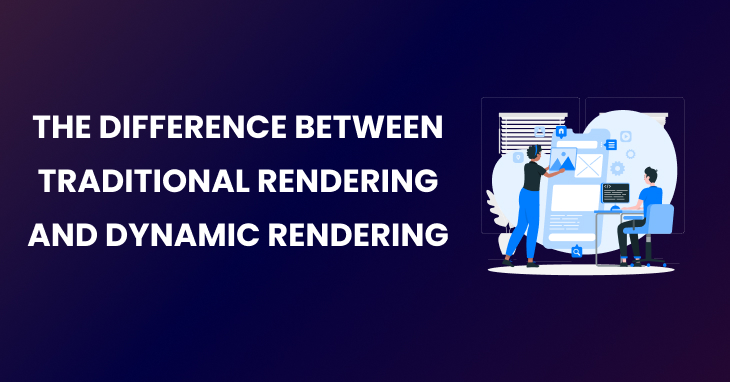I hope you enjoy reading this blog post.
If you want to get more traffic, Contact Us

Click Here - Free 30-Minute Strategy Session
Be quick! FREE spots are almost gone for this Month. Free Quote

Dynamic rendering is a method that serves different versions of a website depending on the device or browser used by the user. This involves providing a static version of a website to search engines while serving a dynamic version to users.
Dynamic rendering involves prerendering and caching web pages on a server, detecting whether a request comes from a human user or a bot using the user agent string and then sending the appropriate version of the page. For human users, a regular client-side rendered version is sent, while for bots such as Googlebot, a pre-rendered version of the content is sent.

Click Here – Free 30-Minute Strategy Session
Be quick! FREE spots are almost gone for this Month
Role of Dynamic Rendering In SEO
Dynamic rendering is designed to provide bots with as much content as possible without requiring them to render any JavaScript, while still providing human users with the full experience of JavaScript-powered content.
The use of dynamic rendering can be beneficial for SEO, as it ensures that content is crawled and indexed quickly by sending Googlebot an HTML version of the pages. It serves the same content to both human users and bots using two separate serving mechanisms.
How Does Dynamic Rendering Impact Websites and SEO?
Dynamic rendering can offer several benefits for a website, including improved speed, SEO and mobile-friendliness. It achieves this by providing a static version of the website’s content to search engine crawlers, resulting in faster loading times and better user experience. This can ultimately lead to better search engine rankings and increased visibility.
Additionally, dynamic rendering can serve a mobile-optimized version of the site’s content to users on mobile devices, enhancing mobile-friendliness and improving search engine rankings since Google considers this as a ranking factor.

Dynamic rendering can be a suitable solution for websites that use JavaScript but do not want to implement full server-side rendering. It can be used as a workaround for publicly available JavaScript-generated content that changes frequently or uses JavaScript features that are not supported by the desired crawlers.
Many modern websites use JavaScript for SEO and rendering specific sections of the content, which may include visual effects or traffic analytics. Googlebot does not need to access these analytics scripts or animations; it only needs to discover the relevant content to display it in search results.
Despite Google’s ability to render JavaScript for several years, research has shown that crawling and indexing JavaScript content may experience a significant delay or may not be discovered at all. Additionally, Googlebot may struggle with some of the latest JavaScript features.
Key Advantages:
Understanding Dynamic Rendering and Its Impact on SEO
Dynamic rendering is a powerful technique that involves presenting different versions of a website to users and search engines. This version typically removes dynamic content like JavaScript and presents it in a format that is easily crawled and indexed by search engines.
JavaScript-based websites are challenging for search engines to crawl and index using traditional rendering techniques. This difficulty often results in poor rankings and reduced visibility.
Dynamic rendering resolves this issue by facilitating easy crawling and indexing of the website by search engines, leading to improved visibility and rankings.

Dynamic rendering can have a significant impact on a website’s technical SEO and overall performance. It ensures that search engine crawlers can access and index content on sites that rely heavily on JavaScript, resulting in more pages being included in the index and receiving organic search traffic.
By serving a static version of a website’s content to search engine crawlers, dynamic rendering can help ensure:
Dynamic rendering also has the potential to make Google crawl and index content faster by removing the cost of rendering JavaScript, which can sometimes slow down Google’s processing of JS-powered websites.
Learn More: How to Fix Crawl Errors in Google Search Console
Google has expressed its views on dynamic rendering, stating that it should only be used when necessary. In 2018, Google recommended dynamic rendering as a temporary solution to the issues search engine crawlers faced when rendering JavaScript-heavy websites.
The solution was suggested for websites that generated large amounts of content using JavaScript, making it difficult for search engine robots to access the content. Google says that dynamic rendering is not a long-term solution for websites with JavaScript-generated content.
Google recommends using other configurations including:
Dynamic rendering does not qualify as cloaking as long as it provides essentially the same content for both users and crawlers.
Also, error pages generated during dynamic rendering are not considered a form of cloaking but are treated like any other error pages. In terms of serving different content to users and crawlers, if a website presents a page about Italy to its visitors while serving a page about Spain to search engines, this may be considered cloaking.

Understanding dynamic rendering requires knowledge of the distinction between traditional and dynamic rendering. Traditional rendering provides all users, including search engines, with a static version of the website that remains consistent across devices and browsers.
On the other hand, dynamic rendering delivers different website versions to different users. For search engines, the version typically omits dynamic content, while the version for users includes all dynamic content. This method guarantees search engines can crawl and index the site while giving users a complete experience.
To implement dynamic rendering on your website, you need to follow a few steps.
After implementing dynamic rendering for your website, there are additional steps you can take to optimize it for SEO:
These technical SEO tips will help ensure that your website is fully optimized for search engines and provides a positive user experience.
Although dynamic rendering can improve the SEO of JavaScript-based websites, it’s crucial to steer clear of certain mistakes.
Dynamic rendering is expected to play a vital role in SEO as more websites adopt JavaScript-based designs. It is believed that dynamic rendering will become an indispensable tool for optimizing websites for search engines.
Furthermore, with technological advancements such as the utilization of machine learning, dynamic rendering is expected to become even more effective.
Dynamic rendering is an effective way to improve the SEO of JavaScript-based websites. It allows search engines to easily crawl and index a website by serving different versions to users and crawlers.
By implementing dynamic rendering and following technical SEO tips, you can optimize your website and improve its rankings and visibility. However, it is important to avoid common mistakes and with the right tools and resources, dynamic rendering can greatly benefit your website’s SEO.
Using dynamic rendering can enhance a website’s SEO by simplifying the process for search engines to crawl and index the site. By serving a version of the website without dynamic content, such as JavaScript, to search engines, the website is more accessible and easily indexed. This can result in improved visibility and higher rankings on search engine results pages.Dynamic rendering also offers the opportunity to optimize dynamic content, like JavaScript code, images, and page load times, leading to an improved user experience and engagement. This can contribute to increased traffic and ultimately better SEO performance.
Learn More: Why PageSpeed is Important?
Dynamic rendering SEO is a technique that optimizes JavaScript-based websites for search engines by serving different versions of the website to users and search engines. Unlike traditional rendering, where a static version of the website is served to all users, dynamic rendering creates a separate version of the website that is stripped of dynamic content like JavaScript.
This makes it easier for search engine bots to crawl and index the website, leading to better rankings and visibility on search engine results pages.
Optimizing the website for search engines through dynamic rendering can ultimately increase traffic and improve SEO.

LEAVE A REPLY